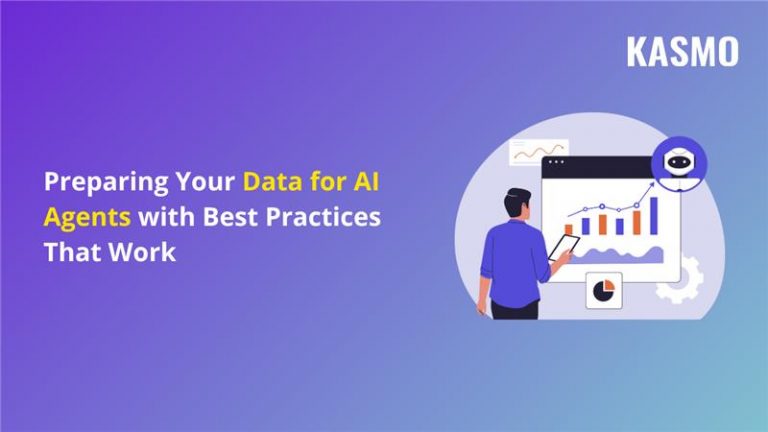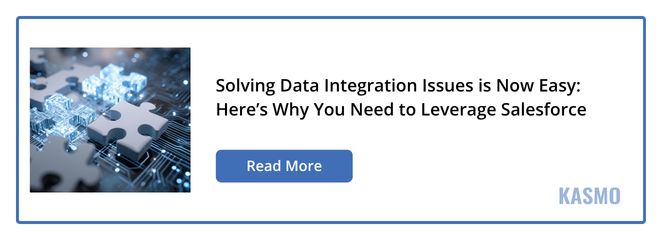AI agents are everywhere. They automate tasks, streamline workflows, and make business operations easier. Businesses are racing to deploy these digital helpers to reduce employees’ time and effort. From chatbots handling customer queries to intelligent systems predicting business trends, they are empowering businesses. But there’s a catch—these agents are only as good as the data they’re built on.
According to Gartner, at least 30% of GenAI projects will be abandoned after proof of concept by the end of 2025, due to poor data quality, inadequate risk controls, escalating costs, or unclear business value. The reality is that without a solid data foundation, even the most advanced AI agents can fail to deliver meaningful results.
So, understanding how to manage your data is critical. In this blog, we explain why data quality is the key to AI agents and how organizations can prepare their data to build high-performing AI.
Understanding AI Agents and Their Data Needs
AI Agents are designed to act autonomously, make decisions, and execute tasks on behalf of users. Unlike traditional AI models, they continuously interact with data sources, learn from real-time inputs, and adapt their behavior. To function effectively, they require clean, consistent, and reliable data. High-quality data is their foundation to understand and deliver accurate recommendations or plan effective actions. Therefore, AI Agents rely on a wide spectrum of data types, some of which are-
Contextual Data: This includes details like location, time, language, and metadata providing critical context. This helps AI agents interpret information more accurately and deliver real-time responses.
Historical Data: They are the patterns and insights from records that enable agents to understand, learn, and refine strategies. This data is essential to make predictive decisions and forecast demands, trends, and growth matrix.
Structured Data: Well-organized data sources such as tables, databases, and spreadsheets are effective for processing, analysis, and reporting. It helps to make more accurate predictions and decisions.
Unstructured Data: This type of data includes content like documents, emails, audio, video, and free text, giving agents the ability to understand natural human inputs and complex text.
Real-Time Data: Live feeds from sensors, APIs, or external systems allow agents to stay updated, react instantly, and adapt to changes. AI agents apply the most accurate models using real-time data to forecast demand, risk, and opportunities.
How Poor Data Sabotages AI Agents’ Performance?
AI Agents depend heavily on good-quality, consistent, and reliable data to deliver expected results. When the data is flawed, like duplicate data, missing information, or inefficiencies, it directly lowers how AI agents perform. Below are the ways poor data negatively impacts AI Agents:

Incorrect Insights and Decisions
We all know that AI Agents learn by identifying patterns in data, while poor-quality data teaches them flawed insights. For instance, a retail AI Agent analyzing mislabeled sales data may see a low-performing product as a bestseller. This leads to misallocated marketing budgets and lower revenue. Conflicting or incomplete data can cause agents to generate false yet confident outputs, often referred to as hallucinations. Also, if training data lacks representation, AI Agents develop biases that reinforce unfair outcomes. Flawed or missing information leads agents to generate misleading recommendations, inaccurate forecasts, and irrelevant responses.
Reduced Efficiency
When data quality breaks down, it directly leads to AI Agents’ inefficiency, turning automation into an obstacle instead of an advantage. Duplicate or outdated data distorts analytics, causing flawed reporting and poor decisions. When a sales AI Agent encounters duplicate customer records, it may double-count leads and reduce conversion rates. Acting on faulty predictions wastes time, money, and effort. This may result in poor operations and increase the risks of financial losses. Processing duplicate records, errors, or gaps by AI agents increases workload and slows down productivity.
Lost Revenue Opportunities
AI Agents are often deployed to uncover patterns that drive revenue, but with poor data, it can be the opposite. Inaccurate demand forecasting data can cause overproduction or stockouts. If an AI Agent bases its predictions on outdated seasonal data, a retailer may overstock products with less demand. It can also affect customer interaction, leading to irrelevant recommendations, reducing engagement, and customer churn. So, unreliable data impacts missed growth, wasted spend, and lost competitive advantage.
Erosion of Trust
The successful implementation of AI Agents depends on user confidence. If your AI agents cause repeated errors, they can erode that trust quickly. Using improper information, the sales AI Agent might suggest the wrong query resolution steps, forcing businesses to revert to manual methods. Also, customers lose faith when AI-driven interactions feel inaccurate. Once trust erodes, there are fewer chances of employees, customers, or leaders accepting AI.
Security Vulnerabilities
Poor data quality creates security and compliance risks. Without strong governance, customers’ sensitive data may be duplicated or stored in unsecured systems. When AI Agents rely on incomplete consent data or inaccurate records, organizations could face regulatory violations, hefty fines, and legal exposure. Fragmented datasets can mask suspicious activity that gives attackers a chance to exploit vulnerabilities. All these expose the business to financial penalties, reputational damage, and cyber threats.
How to Prepare Your Data for AI Agents?
Assess Your Data Readiness
For enterprises, the success of AI agents begins with the maturity of their data environment. A structured readiness assessment ensures your organization identifies risks early, eliminates inefficiencies, and builds a foundation for reliable AI-driven outcomes.
The first step is to map your current data landscape. Integrate data from different sources, whether CRM, ERP, financial systems, or third-party platforms—and evaluate how well these datasets are stored, shared, and accessed. Modern AI initiatives require the ability to process both structured and unstructured content.
Next is to analyze your data pipelines. How efficiently is data moving from source systems into your central repository? If your ETL or ELT processes rely heavily on manual effort, they cause delays and inaccuracies that undermine AI performance. Automated, scalable pipelines ensure faster ingestion, reduce operational risk, and free teams from repetitive tasks. By conducting this readiness assessment, organizations gain clarity and take up enterprise-grade AI initiatives.
Collect and Organize Your Data
AI agents need access to a single, unified view of enterprise data to generate accurate, context-aware outputs. Most organizations operate across fragmented systems such as CRMs, ERPs, IoT platforms, financial tools, marketing applications, etc. By using such data, AI agents struggle to gain accurate insights, which inconsistent performance.
Data integration addresses this challenge by consolidating distributed data into a centralized environment. To achieve this, businesses can use different techniques like data aggregation, API integrations, data filtration, Change Data Capture (CDC), and many more. They create a robust foundation for enterprise-wide data orchestration that helps AI agents to interpret, analyze, and act on information. A properly integrated dataset not only strengthens model training but also reduces the risk of biased outputs, errors, and AI hallucinations.
Clean and Validate Your Data
Manual data cleaning is time-consuming and error-prone. To avoid enterprises can automate pipelines that streamline Extract, Transform, and Load (ETL) processes. These pipelines can standardize formats across diverse sources, reconcile inconsistencies, and check integration of new data into the system. Apart from this, organizations should adopt proactive data quality monitoring techniques like anomaly detection to identify unusual values, missing fields, or inconsistencies before they affect AI performance.
Automated de-duplication routines help eliminate redundant records. By enforcing strict schemas for types, lengths, and formats, businesses can create guardrails that prevent erroneous data from entering the system. Domain-specific checks, like ensuring product SKUs match master catalogs or financial transactions balance correctly to increase reliability. A strict data cleaning and validation process helps AI agents to improve decision-making and deliver desired results.
Create Automated Monitoring Systems
Data keeps adding with new entries, integrations, and updates constantly. Automated monitoring systems track data quality, accuracy, and consistency in real time. Creating real-time dashboards helps to know where poor inputs are undermining recommendations, responses, or predictions. By tracing issues like inconsistent chatbot behavior or irrelevant suggestions, businesses can address problems at the source rather than applying temporary fixes.
Scalable monitoring also requires proactive measures. Immediate alerts help prioritize issues by severity, escalating critical failures and errors. Automated remediation workflows can resolve common data gaps—like missing fields or stale records—without human intervention, preventing bottlenecks. With these safeguards in place, organizations can maintain trust in their AI systems and accelerate adoption.
Adopt Data Governance Policy
Effective AI adoption requires the implementation of robust data governance. Establishing a clear policy around data ownership, access permissions, and compliance requirements is essential. Defining who is accountable for specific datasets—also known as data stewardship—creates clarity and prevents errors that could compromise AI outputs or decision-making. Strong governance also builds stakeholder trust by demonstrating a commitment to security and regulatory compliance.
Without proper governance, organizations might face operational and financial risks. Inaccurate financial reporting, mishandling of customer or employee data, and failure to comply with regulations such as GDPR or HIPAA can result in financial losses and reputational damage. To mitigate these risks and maintain compliance, companies should adopt clear governance policies.
How does Salesforce Data Cloud help to Prepare Your Data for AI Agents?
AI agents rely on high-quality, accurate, and consistent data to generate actionable insights, make predictions, and automate processes. Salesforce Data Cloud helps organizations clean and prepare data for AI agents by unifying disparate sources into a single, standardized model.
Data Deduplication: Data Cloud can consolidate data from multiple sources. It identifies duplicate records and unifies customer or product data into a single source of truth. This ensures AI agents are not misled by fragmented or conflicting data.
Standardization and Normalization: Salesforce applies rules to unify data formats, field structures, and naming conventions, helping AI agents to act on data consistently.
Data Validation: It includes tools to validate data quality automatically. It can flag missing, incomplete, or inaccurate records and apply enrichment processes.
Real-Time Data Cleaning: It also ensures that new or updated data entering the system is immediately checked for accuracy and completeness. Real-time cleaning prevents AI models from acting on outdated or erroneous information.
By unifying and enriching data through identity resolution and pipelines, Salesforce Data Cloud creates a reliable, high-quality dataset. This enables AI agents to deliver accurate insights, automated actions, and relevant decisions while minimizing errors and risks.
Conclusion
Clean data is the fuel that powers AI agents’ effectiveness. AI agents’ performance depends on the quality, consistency, and reliability of the data. Without it, insights become unreliable, decisions can falter, and trust in AI diminishes. Organizations can build a solid foundation for adopting AI agents by making their enterprise data AI-ready. Salesforce Data Cloud helps businesses to unify, standardize, and enrich data with effective capabilities. This high-quality data enables AI agents to generate precise recommendations, forecast trends effectively, and automate processes with confidence. Robust data management and governance, along with minimizing errors, help businesses gain actionable insights, drive smarter strategies, and succeed.




